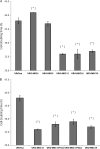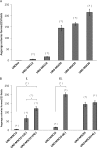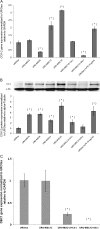Monomethylarsonous acid produces irreversible events resulting in malignant transformation of a human bladder cell line following 12 weeks of low-level exposure
- PMID: 20375083
- PMCID: PMC2886861
- DOI: 10.1093/toxsci/kfq106
Monomethylarsonous acid produces irreversible events resulting in malignant transformation of a human bladder cell line following 12 weeks of low-level exposure
Abstract
Arsenic is a known human bladder carcinogen; however, the mechanisms underlying arsenical-induced bladder carcinogenesis are not understood. Previous research has demonstrated that exposure of a nontumorigenic human urothelial cell line, UROtsa, to 50 nM monomethylarsonous acid (MMA(III)) for 52 weeks resulted in malignant transformation. To focus research on the early mechanistic events leading to MMA(III)-induced malignancy, the goal of this research was to resolve the critical period in which continuous MMA(III) exposure (50 nM) induces the irreversible malignant transformation of UROtsa cells. An increased growth rate of UROtsa cells results after 12 weeks of MMA(III) exposure. Anchorage-independent growth occurred after 12 weeks with a continued increase in colony formation when 12-week exposed cells were cultured for an additional 12 or 24 weeks without MMA(III) exposure. UROtsa cells as early as 12 weeks MMA(III) exposure were tumorigenic in severe combined immunodeficiency mice with tumorigenicity increasing when 12-week exposed cells were cultured for an additional 12 or 24 weeks in the absence of MMA(III) exposure. To assess potential underlying mechanisms associated with the early changes that occur during MMA(III)-induced malignancy, DNA methylation was assessed in known target gene promoter regions. Although DNA methylation remains relatively unchanged after 12 weeks of exposure, aberrant DNA methylation begins to emerge after an additional 12 weeks in culture and continues to increase through 24 weeks in culture without MMA(III) exposure, coincident with the progression of a tumorigenic phenotype. Overall, these data demonstrate that 50 nM MMA(III) is capable of causing irreversible malignant transformation in UROtsa cells after 12 weeks of exposure. Having resolved an earlier timeline in which MMA(III)-induced malignant transformation occurs in UROtsa cells will allow for mechanistic studies focused on the critical biological changes taking place within these cells prior to 12 weeks of exposure, providing further evidence about potential mechanisms of MMA(III)-induced carcinogenesis.
Figures






Similar articles
-
Monomethylarsonous acid induces transformation of human bladder cells.Toxicol Appl Pharmacol. 2006 Oct 1;216(1):69-79. doi: 10.1016/j.taap.2006.04.011. Epub 2006 Jun 27. Toxicol Appl Pharmacol. 2006. PMID: 16806342 Free PMC article.
-
Interdependent genotoxic mechanisms of monomethylarsonous acid: role of ROS-induced DNA damage and poly(ADP-ribose) polymerase-1 inhibition in the malignant transformation of urothelial cells.Toxicol Appl Pharmacol. 2011 Nov 15;257(1):1-13. doi: 10.1016/j.taap.2011.08.029. Epub 2011 Sep 10. Toxicol Appl Pharmacol. 2011. PMID: 21925530 Free PMC article.
-
Interleukin-8 (IL-8) over-production and autocrine cell activation are key factors in monomethylarsonous acid [MMA(III)]-induced malignant transformation of urothelial cells.Toxicol Appl Pharmacol. 2012 Jan 1;258(1):10-8. doi: 10.1016/j.taap.2011.10.002. Epub 2011 Oct 10. Toxicol Appl Pharmacol. 2012. PMID: 22015448 Free PMC article.
-
Mitogenic signal transduction caused by monomethylarsonous acid in human bladder cells: role in arsenic-induced carcinogenesis.Toxicol Sci. 2007 Feb;95(2):321-30. doi: 10.1093/toxsci/kfl160. Epub 2006 Nov 8. Toxicol Sci. 2007. PMID: 17093206
-
Immortalized human urothelial cells as a model of arsenic-induced bladder cancer.Toxicology. 2008 Jun 27;248(2-3):67-76. doi: 10.1016/j.tox.2008.03.020. Epub 2008 Mar 30. Toxicology. 2008. PMID: 18456381 Review.
Cited by
-
Coordinate H3K9 and DNA methylation silencing of ZNFs in toxicant-induced malignant transformation.Epigenetics. 2013 Oct;8(10):1080-8. doi: 10.4161/epi.25926. Epub 2013 Aug 6. Epigenetics. 2013. PMID: 23974009 Free PMC article.
-
Agglomerates of aberrant DNA methylation are associated with toxicant-induced malignant transformation.Epigenetics. 2012 Nov;7(11):1238-48. doi: 10.4161/epi.22163. Epub 2012 Sep 13. Epigenetics. 2012. PMID: 22976526 Free PMC article.
-
Cross-contamination of a UROtsa stock with T24 cells--molecular comparison of different cell lines and stocks.PLoS One. 2013 May 17;8(5):e64139. doi: 10.1371/journal.pone.0064139. Print 2013. PLoS One. 2013. PMID: 23691160 Free PMC article.
-
Arsenic and Human Health: New Molecular Mechanisms For Arsenic-Induced Cancers.Curr Pollut Rep. 2023 Dec;9(4):784-797. doi: 10.1007/s40726-023-00278-3. Epub 2023 Aug 23. Curr Pollut Rep. 2023. PMID: 40656132 Free PMC article.
-
Akt activation is responsible for enhanced migratory and invasive behavior of arsenic-transformed human bronchial epithelial cells.Environ Health Perspect. 2012 Jan;120(1):92-7. doi: 10.1289/ehp.1104061. Epub 2011 Sep 27. Environ Health Perspect. 2012. PMID: 21954225 Free PMC article.
References
-
- Achanzar WE, Brambila EM, Diwan BA, Webber MM, Waalkes MP. Inorganic arsenite-induced malignant transformation of human prostate epithelial cells. J. Natl. Cancer Inst. 2002;94:1888–1891. - PubMed
-
- Aposhian HV, Gurzau ES, Le XC, Gurzau A, Healy SM, Lu X, Ma M, Yip Li, Zakharyan RA, Maiorina RM, et al. Occurrence of monomethylarsonous acid in urine of humans exposed to inorganic arsenic. Chem. Res. Toxicol. 2000;13:693–697. - PubMed
-
- Benbrahim-Tallaa L, Waterland RA, Styblo M, Achanzar WE, Webber MM, Waalkes MP. Molecular events associated with arsenic-induced malignant transformation of human prostatic epithelial cells: aberrant genomic DNA methylation and K-ras oncogene activation. Toxicol. Appl. Pharmacol. 2005;206:288–298. - PubMed
-
- Bredfeldt TG, Kopplin MJ, Gandolfi AJ. Effects of arsenite on UROtsa cells: low-level arsenite causes accumulation of ubiquitinated proteins that is enhanced by reduction in cellular glutathione levels. Toxicol. Appl. Pharmacol. 2004;198:412–418. - PubMed

